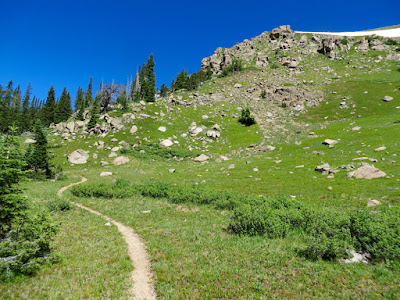Distance: 8.5 miles round trip
Elevation: 10,460 ft - 12,282 ft
Elevation Gain: 1,822 ft
Dogs: Off leash
Bathroom at Trailhead: No
Tags: #coloradooutdoors, #hiking, #mountainlake
Nearby hikes:
Lenawee,
Argentine Pass
 |
| The deep blue waters of Chihuahua Lake |
Chihuahua Lake near Keystone, CO in Summit County is a large glacial tarn nestled at the base of Grizzly Peak. The trail to the lake is not for soft paws however, being very rocky and filled with deep water crossings even in late summer. Additionally, the last pitch to the lake is a steep rock scramble requiring both agility and perseverance. The reward for those strong enough is a stunning view of the back side of Grays and Torreys and a pristine lake filled with deep indigo waters.
 |
| Heading up the lower portion of the jeep road |
 |
| Passing a large boulder field |
The first 2.7 miles of the trail follows Forest Service Road 263 and you will not be alone on this segment. I was quite surprised at the number of vehicles that passed us both coming and going because this is a road only for the hardiest of drivers. Because of this traffic, the road is very rocky and rutted which makes for a jarring experience.
 |
| First stream crossing. This plank leads to a round log half way across. |
This road crosses Chihuahua Creek twice (at 1.2 and 2.0 miles) and in both cases, the water is deep, even in late summer. After seeing the extent of the beaver activity throughout the valley, I doubt the creek ever dries out. Water shoes and a pole are a must unless you don't mind wet feet. At the lower crossing, someone had tried to put a plank across to a large fallen log in an improvised bridge, but this structure will not survive next spring's run off. At the upper crossing, there were a few rocks that the more nimble were able to navigate. I found myself slipping off them into the water anyway.
 |
| Rutted section of the jeep road |
In addition to these stream crossings, there are several places where the road itself is habitually flooded. Short social trails into the willows avoid the deepest areas but others require more slogging through bogs.
At 2.7 miles the jeep road ends at a small parking area with a wooden fence and small sign pointing upwards. Technically, this is the start of the trail, but only true 4x4s can make it to this point. For the next half mile, the trail struggles relentlessly upwards on a steep and highly eroded path reminiscent of an approach to a 14er. This segment ends at a narrow tundra shelf surrounded on both sides by barren peaks.
 |
| Soggy section |
 |
| Saddle between Grizzly and Torres Peaks |
The trail continues eastward along this shelf before turning sharply upwards on the last scramble to the lake. As you approach this area, it is difficult to tell where to leave the flat and head upwards. Several narrow, eroded drainages pour down the hillside and look like a trails. Fortunately, two people were ahead of us and we followed them to the far eastern side of the valley where the grade is less vertical. Careful scouting will reveal the route that is mostly over scree but occasionally dirt. The last 100 yards is very steep, often requiring the use of hands to pull oneself upwards. Anyone with moderate fitness can navigate this section without difficulty if they take care to keep from sliding down in the loose dirt.
 |
| Trail sign and wooden fence |
 |
| Heading up rocky segment to final shelf |
After the scramble, the trail continues upwards for another quarter mile before cresting on a high cliff overlooking the lake. A journey down to the water requires additional scrambling down a passable gully.
 |
| Looking back down the valley and beaver ponds below |
Chihuahua Lake has been on my do list for a long time. I never seemed to be around at the end of the season when I had assumed the water crossings would be more manageable. Now I know that they will most likely always be there, so you just have to plan accordingly. The obstacles, while annoying, are not particularly difficult to surmount and the views of
Grays and Torreys are something to behold. The saddle between Grizzly Peak and Torreys is so small and easily scaled that it makes you want to run up to the summit and down again in a fit of joy.
 |
| On the final pitch before the lake |
 |
| Chihuahua Lake |
To get to the trailhead, take exit 205 off of I-70 (Silverthorne/Dillon) and travel east on highway 6 toward Keystone. Just past Keystone, turn right onto Montezuma Road (County Road 5). Follow Montezuma Road for approximately 4.6 miles and turn left onto Peru Creek Road (FSR 260). Follow Peru Creek Road for approximately 2.1 miles and park along the side. The only marker that you have reached the parking area is a small brown sign on the road to the left with the number 261 on it. Other cars will be your biggest clue. Peru Creek road is passable with a passenger car to this point but can be rutted and full of washboards.






















































